main: October 2007 Archives
Some tiny parts of Miami wish to be sophisticated, but what can you do?!?!?! At home in Buenos Aires, Bogotá, London, New York and Berlin, the same people support a refined sensibility. But at their second home (or third or fourth) condo, they just let it all pass. Boats, nightclubs and alcohol - socializing, not thinking.
The Sagamore Hotel with its hip contemporary art collection in the lobby - encourages or sponsors - Spencer Tunick to take pictures of naked people. Tunick stepped to a new low. On Monday October 8, 2007, Spencer Tunick chose the balconies and swimming pool for mass nude photographs "with neon pink and green rafts and about 500 bottles of champagne, which he directed models to simultaneously shake and explode like a human fountain." Best photos at thewest.com. Maybe Tunick was stumped by a place where everyone is basically nude all the time. So he reached for pink and plastic to signal the city.
Models setup for a Spencer Tunick photo. (Photo: thewest.com)
Pink continues to return as the Florida color. Christo utilized it for island wrap more than 25 years ago. Pink flamingos have graced the intro to "Miami Vice" and thousands of tourist brochures even though the bird is NOT native to Florida. Unfortunately, the color is disappearing on buildings after decades of pink retirement villas and condos.
Britto installed his Pyramid in Hyde Park, London. Worse than I imagined - but now a new symbol for Miami. Where are the quality control police? News release produced by the materials manufacturing company, Innovida.
Pyramid for King Tut Show in London at O2
Britto is only making his work bigger. He has a lot of work ahead to invigorate his art through public art as per Chihuly. See earlier aesthetic grounds essay.
Digg it...Del.icio.us ...Technorati...Stumble Upon..Reddit
One sequence from Mira Nair's 2006 film, "The Namesake" features the public art project "Travelogues" by Elizabeth Diller and Ricardo Scofidio. Nair is mixing the storytelling of travelling in the film with the storytelling and animation of the artwork. Also a good film.
In a mindless moment, I was flipping channels and discovered the "Notila Fairytale" video by Venessa Carlton. According to my wife, who teaches primary school art, Ms. Carlton's music is popular with suburban pre-teens. This may account for the fairytale website and video images. (Comparing the urban vision presented by Ms. Carlton with Madonna's pre-teen videos "Into the Groove" and Desperately Seeking Susan might be interesting).
For the video, Ms. Carlton's team invented a series of public art projects inspired by the Grimm Brothers and other fairytales. For the public artist and critic, the video is a catalogue of every type of urban public art invention being utilized today. What does it mean that this visually naive musician should instinctly grasp these prime artistic methods? Has public art achieved a generic public understanding like hip architecture?
Ms. Carlton is interested in capturing this neighborhood recently marketed as Nolita (North of Little Italy) in Manhattan. Her video team integrated people from the street. Like the best public art, the traveler does notice these people in a place and forms a mental concept. The people are events - not just images. Gang of ice cream eaters, a black guy and white guy in the same T-shirt, a sad performer and white-suited man on his way someplace where the suit is appropriate attire.
More public art must capture an event, generate an event or imagine one. Most public art will continue as
a.) better design (visual, spatial and ecological);
b.) 2-D & 3-D civic photographic albums and educational lessons and
c.) contemporary artwork on display,
but the event is always the final power of all physical stuff. The human made elements that we value come from association with past events and projected future ones. Diller & Scofidio in NYC and Buster Simpson in Seattle understand better than most.
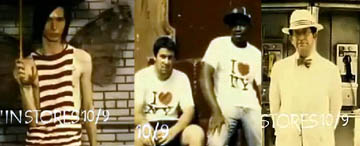
People as texture of the place.
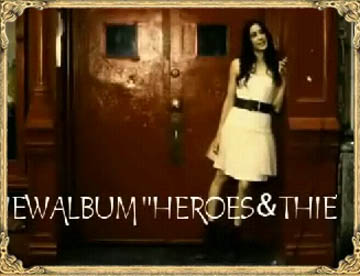
Old Trick: Contrast of material, color and delicacy
Trend: Giant animals in odd locations for spatial orientation in the city
Trend: Placemaking in the street
Trend: Graphic design
Trend: Narrative meaning added to architecture through design integration.
Trend: Suggestion of a past or future event / or / an event caught in time
Trend: Photo documentation of a place or city
Trend: Unusual use of pre-fabricated, street worthy items.
Trend: Mini-museum display of diversity of form of common objects
Nolita Fairytale by Venessa Carlton on Youtube
Better version at her website: Venessa Carlton
Digg it...Del.icio.us ...Technorati...Stumble Upon..Reddit
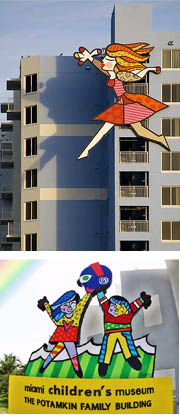
Romero Britto's Company is attempting to become the Dale Chihuly of Miami. Like Chihuly in Seattle, Britto is basically a local boy that is achieving worldwide artistic fame from home and thus emerges as an image for the City itself. Unlike Chihuly, the Britto Company ignores the museum circles or artculture. His team follows Peter Max nearly step-by-step minus some association with Rock and Roll or equal. Both Max and Britto Have sold on cruise ships, designed United Nations stamps, created imagery for international sports events, volunteered for good will fiberglass sculpture events and painted airplanes and cars. According to the New York Times, the company's 2006 revenues exceeded $12 million dollars.
Normally, the public art establishment would ignore Britto as they ignore the other mass producers of colorful or slightly sexual prints and small sculptures. The artculture still overlooks him until the President, Governor, Provost or Mayor proudly accepts one and places it at the entrance to some important non-museum building. A minor irritation.
Artbrokage.com is a good resource of this financial successful artists. The leading artists ranked by works for sales are: Erte (317 works for sale), Salvador Dali (307), LeRoy Nieman (299) and Peter Max (154) with good showing by Warhol, Rockwell, Wyethe and Haring. Many, many artists outside artculture are doing very well: Royo, GH Rothe, Ting Shao Kuang, Itzchak Tarkay, Oleg Zhivetin, Frederick Hart and Guillaume. Azoulay, Of these artists, I have only heard of Hart because he made the mandated figurative sculpture of three Vietnam soldiers for the Mall during the protest about Maya Lin's memorial.
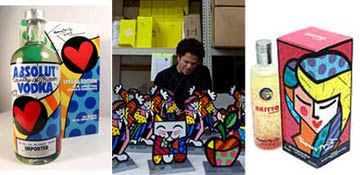
Mass Production: Vodka, Signed Editions of 1000, Perfume
Like the bronze sculpture establishment, the mass producing printmakers have an entirely independent system from artculture. The printmakers are very entrepreneurial and go directly to the customer through stores / galleries located where their customers shop. They have no patience to wait for the artculture system of artcenters, hip galleries, museum curators and art critics. The covers such as Life magazine (Max in 1969) or features on the person, not the art, is the focus of public relations team.
For the printmakers, the sale of the original painting is a minority of income compared to the prints. And of course, the prints are cheap to produce. So depending on the prestige of the potential clients, originals or prints are almost given away. Britto's high contrast graphics look great in poster printing, even cheaper to distribute. When I first toured Miami Beach city hall in 2001, it appeared that every department lobby and several elected officials had a free Britto.
As Britto may have learned from Caribbean artist, Guy Harvey, printing art on anything - cups, T-shirts, fishing rods - has a positive effect on distribution of the imagery. The goal of the marketing is to familiarize a broad audience with the imagery and its appreciation by the rich and famous. Both Britto and Max (following Warhol) produced prints of some famous clients. (Harvey - a former Marine scientist turned artist - sticks to middle class sales among fisherman). Britto company by 2004 had licensed imagery for clothing by designer Nicole Miller, shoemaker Via Spiga and watchmakers Swatch and Movado
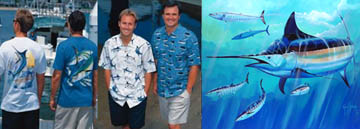
Guy Harvey: All Fish and Fishing All the Time
As a curse of marketing the imagery instead of the artist, the artist cannot change or modify. He is trapped for an artistic lifetime. (I use "he." I don't know a female success story)
Trapped in his imagery, Britto has launched into public art - A place the other mass producers have avoided. A diversity of public artworks provides Britto with a new direction and energy without threatening the now branded imagery. Even the Art Basel/Miami machine woke up in 2005 when Britto's relationships with real estate developers resulted in a proposed public sculpture in Miami Beach. An "Ocean Drive" article wonders if more Britto sculptures will turn the Art Basel crowd away from Miami Beach. What paranoia.
But the public projects in the last 24 months has solidified Britto as THE MIAMI ARTIST. Through his friends - perhaps Gloria Estefan - he designed imagery for the 2006 Superbowl Pre-Game Show. His cat sculpture appeared on the lawn of the Florida House in Washington DC due to the relationships with then Governor Jeb Bush. A 45 foot "Welcome" sculpture at the entrance to a huge Simon owned "Dadeland Mall". Various public spaces in Bar Harbor, Hollywood and Kendall have 10-foot Britto sculptures. This summer a Britto appeared at the Children's Museum on the Causeway to Miami Beach and directly on I-95 as tens of thousands of drivers enter and leave downtown Miami.
The Ultimate: 2006 Miami Superbowl with Cirque du Soleil
The Whole 9 Minute Superbowl Show with Cirque du Soleil
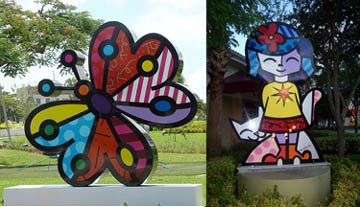
Public Art Spreads: Hollywood and Kendall, Florida
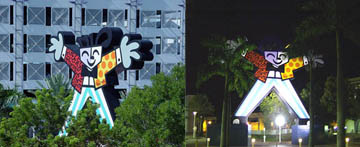
Public Art: The First Big One "Welcome"
Jeb Bush brought Britto to Washington, DC in 2006.
Brazilian Plane: Following Calder and Max
His 2nd and 3rd Cars: Volvo Car Show and Audi for Chicago Art Show
Fiberglass Public Art: Representing Miami
Learning from Peter Max: Royal Caribean Cruise Lines
For the public art world, none of his projects except the bus wraps at the Fort Lauderdale Airport were selected through any public process. This is especially annoying because some of the work has been financed in part with public dollars. The Britto Company goes directly to the politicians and department directors.
But this week, Britto hit a wall of private negotiations for the use of public space. The Miami Airport announced that it would like to have all its employees wear Britto designed shirts. An amazingly smart and arrogant move. Just as the Miami-Dade public art program is about to unveil millions of dollars worth of artist designed walls, ceilings and floors at the airport, Britto applies his imagery everywhere for a fraction of the cost. For the moment at least, the Miami -Dade Commissioners find the shirts "tacky" and unacceptable, but nothing in Miami politics is over, until it's over.
Proposed Employee Shirts for Miami Airport
Buses at Fort Lauderdale Airport, (Public Art Selection Process)
At age 44, Britto will continue to find new bolder directions for the application of his work or he will quietly sell the prints and attend great parties. Chihuly had this choice his mid-fifties and developed the "Chihuly over Venice" installations. Combined with the Steve Winn's commission for the Bellegio in Las Vegas, Chihuly escaped the glass bowls and objects and embarked on his best work. The series of installations in gardens during the last ten years may be the most purely beautiful public art of the late 20th century. The Phipps Garden project is still open until November 11. Go. (Chihuly has an excellent website.)
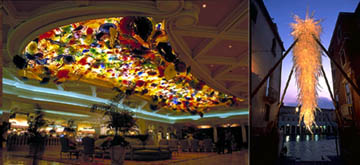
Chihuly First Installations in Las Vegas '97 and Venice '96
Chihuly at Phipps Gardens in Pittsburg until Nov 11, 2007. GO ----
On October 30, Britto opens his Pyramid in London. One pyramid was made with children and another by Britto himself. Britto goes international seeking new challenges for his black lines and primary colors. I will post the results when available.
Parts of the "O2" Pyramid: Unveiled on Oct 30 in London
Thanks to Critical Art Miami Blog and Miamism for Help.
Digg it...Del.icio.us ...Technorati...Stumble Upon..Reddit
Except for a few months here and there, I was never noted for my hipness. Or even really knowing what was "in" at any moment in time. With that caveat, I just discovered Jamie O'Shea's blog - Supertouch. O'Shea was the editor-in-chief of Juxtapoz magazine from San Francisco for ten years. Now he is editing a start-up lifestyle publication called Spread Artculture. (Even though the meaning is not the same, I think I will use "artculture" and abandon "artworld".)
Supertouch - unlike most blogs - has real clarity of image selection. O'Shea has a great eye that is guided by a sharp mind. Select art tags and just watch. Be sure to click on the "more" as he always includes a full range of pictures to TOTALLY explain the situation.
O'Shea's selection is today's "high" culture. He finds a crisp version of the street that includes graffiti, cartoons, installations, sci-fi, performances, tattoos and humans. Music and zines are always conceptually or actually nearby. He prioritizes New York, California, London and Tokyo. The cool trek.
He has a true visual point of view. Not a style, (although sci-fi and skulls are more than appreciated) but rather a knowledge that he has found a creator that he likes. And O'Shea's creators communicate visually his or her method of living in world.
O'Shea does sense some similar trends that I agree with - bling as a broad cultural influence, mixing up religion and culture and the crossover in both directions between graphic artists and public artists.
Kenji Yanobe in Tokyo
Aaron Young mixes Hells Angels and Jackson Pollack
Panda in the Brian Griffiths' "Life is a Laugh" in the London Underground
Digg it...Del.icio.us ...Technorati...Stumble Upon..Reddit
I don't type much about my professional work, but I have managed some public art programs and curated some exhibitions. Through this leadership, I have attempted to find the unique artistic forms of a community and celebrate them. "Artform of a community" could mean 1.) work by special local artists, 2.) visual art appreciated by at least one sub-culture group, and 3.) other locally appreciated arts or cultural attributes interpreted by visual artists. All artists making visual or spatial forms are welcome including painters, sculptors, musicians, quilt makers, landscape designers, architects, graphic designers, web designers, filmmaker, etc.
Sometimes an idea has passed through my skull that just seems like the "right thing to do." Occasionally, the right thing has involved working with the wrong artists - according to the professional public artworld that is just now convincing a majority that modern art and integrated art are OK and that experienced public artists should design the work.
Two very inexperience public artists I wanted for the Fort Lauderdale Airport in Florida were Peter Max and Carnival King / Queen costumer makers from Trinidad. Peter Max did enter the competition for the new rental car parking facility, but lost to James Carpenter. I could not get anyone to take the costume makers seriously.
Peter Max is the most popular artist on cruise ships in the Caribbean and the Fort Lauderdale airport links operationally to the ship terminals. Hundreds of thousands of people fly to the airport and spend a week cruising with images from the 1960's pop icon. He helped invent the visual imagery associated with late 1960s rock and roll - America's most popular artform of the economically dominant baby boomer generation.
Peter Max prints available on cruise ships in Fort Lauderdale

Garage facade at entrance from cruise terminals and US 1
Yes, Peter Max had no official public art experience, but it would not be difficult for experienced architects to assist him and add his image to the main entry wall that is the size of a football field. But the problem was not his lack of experience, but his association with the money making side of the artworld. He is COMMERCIAL. Willing and ABLE to sell his images for T-shirts at a substantial royalty fee.
Of course selling T-shirts to tourists is a prime function of Fort Lauderdale beach retailers. Peter Max is one of the few artists that understands and could respond to the tourism industry - the engine that runs south Florida.
Not to deep below the surface in the public art establishment, a strong preference exists for selecting non-commercially successful artists. These artists ( curators and administrators ) think something is morally questionable about someone that strives aggressively to sell their art. It is assumed that normal public artists have an ethical superiority through their dedication to the site and/or community. These primarily untrue assumptions (judge the individual not his or her group) can have very little to do with finding the most valuable artworks for a community at the right moment. (Ironically, a few popular public artists ask for to $2,000 a day plus expenses.)
Several public art programs - especially at airports - have lined walls with display cases for creations other than public artworks. Frequently these cases will include traditional arts and crafts from the region, an admirable project. What is infrequent is commissioning those artists for large-scale works. The exception might be a pre-made system like the floor medallions at the National Airport in Washington, DC, where one fabricator took the artist drawings and converted them to terrazzo. This type of exception can steal the power of the original work through uniformity
Artists from Trinidad stitch together huge costumes of lightweight materials. The model must walk with the costume on his or her back. Self-taught artists in traditional and contemporary materials have converted the Kings and Queens Costume contest at the end of Carnival in Trinidad into a circus-like event. The costumes are translucent with fabrics, feathers and shiny reflective materials. Formally, the shapes and patterns radiate from the model.
Trinidad Carnival King Competition
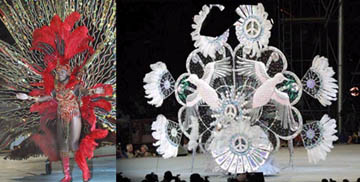
Trinidad Carnival Queen Competition
The white visitors to south Florida generally throw all the people with dark skin into the generic "Black" category. People of African descent are their own black melting pot unlike other areas of the USA. Even in 1900, the African-Americans here were just as likely to be from the Bahamas as South Carolina. Today, it is very easy to find people whose families are from Jamaica, Haiti, Cuba, Dominican Republic, Bahamas, Brazil and all the small islands in the Caribbean Sea.
As is typical of a dominant culture anywhere, the flavor of the minority may be celebrated, but the people are ignored. Any cultural expression should be made in their assigned ghetto with nice names like "Little Haiti". This race matching is still a bad habit in public art and other cultural realms.
The airport is a dominant culture zone despite the realty of the people flying and working. The prospect of many 15-foot diameter Trinidad costumes floating from the ceiling of the main terminal of the Fort Lauderdale airport might have been too powerful an image. Instead the history of the toy airplane is displayed (NOT a Broward County public art project.)
History of toy airplanes in Fort Lauderdale terminal
I started this essay when Google sent me a dispatch from India regarding the demand for "permanent" fiberglass Durga Puja sculptures instead of the temporary mud and straw icons. According to writer, Chandrima S. Bhattacharya, religious sculptures are being shipped to Indian communities worldwide as a religious symbol that is transforming into a cultural symbol. Indians in London or New York install these Durgas with her ten arms in hotel lobbies all year round instead of the temple or other gathering place for 5 days before completing the Hindu ceremony by throwing the artwork into a river.
Amar Nath Ghosh, a leading shoal-artist of Kumartuli, works on Durga sculpture
At the British Museum in 2006, artists from Indian made a traditional mud and straw Durga sculpture. At the end of the exhibition, the Hindu community took the sculpture to the Thames for the river's first Durga Puja ceremony.
Both these events located outside of India by people of Indian descent start the change from religion to culture. The cultural leaders of the dominant and minority cultures actively participate in the removal of sacred attributes and focus on the visual splendor and associated myths and music. The religious symbols become neutralized.
In all three situations - Peter Max, Trinidad Costumes and Hindu icons - the realm of public art insist upon neutrality or a removal of any powerful emotions related to the sociological connotations of the work. Yet these connotations provide the deep power of the artwork.
How do we hold onto the power without scaring away the culturally fearful? Only by finding this answer do we stand a chance of inventing a new human diversity for the future of the planet. Through its civic ownership and physical locations, public art can be a testing ground.
King Costume in the Trinidad Street Carnival
Trinidad King and Queen Competition (from thebookman)
One Giant Costume (from thebookman)
NOTE:
If you are in St. Louis, Missouri, on October 19-21, a Durga sculpture by the master artist, Arar Nath Ghosh, will be part of the Durga Puja celebrations at the Mahatma Gandhi Center. The event is organized by the Punascha, the Bengali Association of Greater St. Louis. If you live somewhere else, just google "Durga Puja Celebrations" and you can find them throughout the world.
UPDATE FROM RIES in SEATTLE
Peter Max created a new interior artwork for the Houston airport two years after my Peter Max story. In 2000, he painted an Continental Airlines Plane. See Ries' other thoughts in comments.

Digg it...Del.icio.us ...Technorati...Stumble Upon..Reddit
Channel 4 in the London is sponsoring a series of public art projects: A mobile phone mob blog, seven new public artworks on viewer nominated sites and the Big 4 below. (From the Channel 4 Website )
Channel 4 is bringing its '4' logo to life in a major public art commission linked to the Big Art Project.
In the run up to the Channel's 25th anniversary on 2nd November (2007), a 50 foot-high metal '4' has been constructed for the steps of the Channel's headquarters in Horseferry Road, London SW1.
The towering installation will mirror the channel's on-air identity with metal bars forming the instantly recognisable logo only when viewed from a particular angle.
The Big 4 project is the first time the Channel has commissioned public art for its headquarters, which was built by the Richard Rodgers Partnership and opened in 1994.
The Big 4 was designed by architecture/design group Freestate in conjunction with award-winning engineers Atelier One. The Big 4 will be used an armature for installations by the following artists starting with Nick Knight this fall.
· British fashon photographer Nick Knight (Knight's modification at top of page)
· Ghanaian sculptor El-Anatsui
· Turner Prize nominee Mark Titchner.
(End of Channel 4 Website Quote)
Others have tried the big letter or number over time with Robert Indiana's "LOVE" as the most famous. This kind of artwork succeeds by its "in-your-face" directness. It's a big number and that's all. The Freestate "Big 4" inverts this methods and physically, but not intellectually, deconstructs the numeral. It definately feels like an armature waiting for the art - which is the design intent.
Robert Indiana - Venturi, Scott Brown - Ivan Chermayeff
In regards to the lines coming together from a single vantage point, see the Aesthetic Grounds essay on Italian perspective and the new 2007 UK project of Felice Varini plus the 2007 Landmark Wales competition. Infanger and Parkers' Landmark Wales entry forms a dragon shape in one view. The renewed popularity of the vantage point artwork must be in response to the accessibity of video production. The artwork is designed to solidify and break-up when the viewer and his/her camera is in motion.
Felice Varini, Cardiff Bay Barrage, Wales
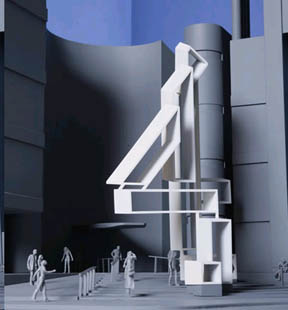
The Big 4 breaks apart as the viewer moves.
I will have to wait for the Flickr images, but it appears that the viewer must stand in the street to merge the shapes into a "4".
Digg it...Del.icio.us ...Technorati...Stumble Upon..Reddit
Sharon Louden at Yahoo Headquarters: New Lawn and Louden's grasses
In the last month, the arts blogasphere including Artsjournal.com has been buzzing with the damage and lawsuits regarding two landscapes: "Wildflower Works" by Chapman Kelley in Chicago and "Reflecting Tips" by Sharon Louden in Sunnyvale, California. The basic information and newsclippings are at Edward Winkleman's Blog. The best articles are by John Auturo at CAC Discussion (Kelley) and by Kelly Crow at the Wall Street Journal (Louden).
In both cases, practical fuzzy rationale by the landowners, City of Chicago and Yahoo, led to the modifications in the works. The owners implied that Chicago needed a place for Frank Gehry's pedestrian bridge to terminate and Yahoo needed to comply with the "cut lawn" ordinances on Sunnyvale. - Both are untrue, but sound accurate. When you look a little farther, the situation returns to one powerful person that doesn't "like" the art or sees no reason why it can't be modified to meet current needs. Or frequently does not recognize the plants as art or part of the artwork. The room of assistants and project manager's are usually silent. Calling the artist is usually considered a big public relations' risk. Better to deal with the situation later.
Well, 75 year-old Chapman Kelley took the City of Chicago to court and won under the Federal VARA (Visual Artists Rights Act) statue. Destruction of an artwork requires consideration and is not an absolute right of ownership. This is huge step for VARA as the previous VARA lawsuit regarding site design failed in Boston. In 2003, artist David Phillips sued Fidelity Investments for modifying his site design for Eastport Park on the south Boston Waterfront. Phillips' bronze and stone sculptural elements were preserved, but not the site relationships. The judge held that only the indepentent sculptures were protected by VARA. (See below for links). Loudon has not taken legal action.
In addition to the legal issues, the situations interest me due to the common artistic sensibilities of Kelley and Louden, the common city "Green" building ambitions and the failure to recognize site -but especially plants - as integral to the artwork.
Kelley and Louden could be father and daughter ( 75 and around 40) working in the materials of their respective times. They seem born with the same sensibility for standing on the edge between delicate and permanent and the flucuating and stable. The Chicago and Yahoo works are their only outdoor commissions as Kelley is an oil painter and Louden an installation and video artist. When creating, they both relied on plants for the fragility of the present, the messily of the order and the energy of annual rebirth.
Louden and Kelley: Daughter and Father????
Louden and Kelley: Daughter and Father????
Louden and Kelley: Daughter and Father????
The city government of Chicago touts itself as the number one major "Green" city in America and Sunnyvale has begun to incorporate green attributes into its civic efforts. Yet in both works, the cities destroyed drought tolerate landscapes and replaced them with thirtsy lawns. In the comparitive pictures of Kelley sketch and a tower photo of the new Frank Gehry theater and pedestrian bridge, the city replaced the wildflowers with lawn and manicured flowers. Sunnyvale's muncipal code requires "water conserving plants shall be installed in 70% of all landscaped areas" and the drought tolerate grass are in front of the Yahoo sign. But still our culture inside the cities or suburbs cannot accept the "look" of the native landscape of messy grass or flowers from the hills above Silicon Valley or the prairies of Illinois. The lawn remains the dignified vision for civic spaces and corporate headquarters.
Drought tolerant plants at Yahoo sign and native landscape grasses.
After so many years and an assumed understanding within the museum artworld, landscape and site is still not part of the common perception of art. The "object" rules the preconception as can seen in Yahoo's protection of Louden's reflectors and Fidelity's respect for Phillips' objects. Honoring a site requires a sensibility from an owner of property that even architects and landscape architects rarely see and that almost never transfers to a new owner. At least one judge - David H. Coar - respected the landscape as art. But I don't know he felt the space with its order and objects introduced by the artist. This may be a futile dream in a world of that eliminates more public ownership everyday and solidifies land as personal property, no matter how public.
Chapman Kelley Watercolor of 1984 Concept for Wildflower
Recent photo with Gehry theater and bridge. Note the continued ovals.
LINKS FOR DAVID PHILLIPS VARA LAWSUIT
Start with Holtz-Kay essay.
Jane Holtz Kay Essay
US Curcuit Court of Appeal Opinion
Mass Court Opinion
Halvorson Design, Landscape Design
David Phillips
Pembroke Real Estate
Boston University Arts Administration Newsletter
Phillips Photograph of Orginal Work
Digg it...Del.icio.us ...Technorati...Stumble Upon..Reddit
On July 26, 2007, a bronze sculpture of young Elvis Presley was installed in Honolulu. The life-size figure is the sixth and final "TV LAND" donations to the citizens of NYC, Minneapolis, Salem (MA.), Chicago and Raleigh (N.C.). Except for Elvis, the artworks depict actors in their roles as popular characters from television shows of the 1950s, 60s and 70s. All are displayed in the actual cities that served as the settings for the fictional polite comedies. (Except Andy Griffith. See note)

TV Land Website on "Landmarks"
As Milwaukee announced that the tourism bureau was raising funds for "The Fonz" from "Happy Days", I wondered about this industry of bronze figures. Many public art administrators and all contemporary art museums and centers ignore this group of artists like a disease - get too close and your professional career will be ruined. As a result, the museum crowd knows nothing about what is going on. We only come in contact with the industry when contemporary sculptures uses the same foundries, when conserving historic sculptures and when facing the disappointed citizen that cannot persuade the city arts commission to purchase a bronze figure.
Scottsdale Community Sculpture: A Scottsdale Mayor, Generic Officer, Scottsdale Founders
Artists: Clyde Ross Morgan, AZ Bronze, George-Ann Tognoni
Some agencies like Scottsdale, Arizona, have a special category for bronze sculptures. A community group secures approval for the project and location from the Arts Commission and then must raise the necessary funds. To facilitate, Scottsdale provides a list of sculptors and foundries.
In 2000, TV LAND initiated the program with Jackie Gleason as "Ralph Kramden" from the "Honeymooners". Rather than curators or consultants, they turned to producer of artistic stuff like logos and award trophies - Robert Du Grenier. After deciding on the pose and other design elements with TV LAND, Du Grenier hired nearby artist Lawrence Nowlan to create the bronze figure. Not working out perfectly, for the "Mary Richards" sculpture related to the "Mary Tyler Moore Show", TV LAND asked the City of Minneapolis to find the artist - Gwendolyn Gillen - and manage the project. Not working out perfectly, TV LAND turned to the big daddy of bronze and wax figurative production in the USA: Studio EIS of Brooklyn, NY. Elvis is their fourth sculpture for TV LAND.
TV Land: Samantha, Ralph and Mary
Producers & Artists: Studio EIS, DuGrenier/Nowlan, Gwen Gillen
Studio EIS: Large producer of bronzes from photographs
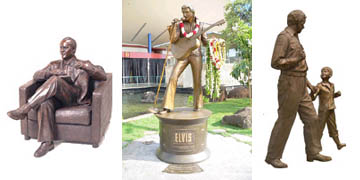
TV Land: Bob, Elvis and Andy
Producers: Studio EIS
Studio EIS clarified for me the purpose of these particular bronze sculptures in the public realm - a freestanding photograph. At the request of clients, EIS will take any photograph and convert it to bronze or wax or whatever material. The talented EIS artists reproduce, not interpret. The client evaluates through comparison with the original - not the person, but the key, publicly known photographic image. (Other foundries like Arizona Bronze and American Foundry will perform the same tasks)
For a minute forget all the stuff about men on horses and cultural prestige of bronze, see the sculpture as a picture in an album, book or local history museum. Wow, so that is what she looked like. I didn't know he lived here. Funny shoes. I can't believe people today like that monster. When I was a child, she walked up and down the street like she owned it.
The photograph generates these thoughts. As soon as the artistic interpretation expands beyond a little extra texture, the artist now interferes with the pure simple memory. The viewer must battle the artist.
Of course for the contemporary art community, feeling the artist is the point of most 20th century museum art. They want their preconception to be interfered with. They like the tension with or expression of the original person and artist's vision. As Robert Venturi wrote in the 1960's, "both/and."
Despite the skills of the artists engaged in making these bronzes from photographs, the bronzes are not art at all. The key proof of this fact are the faces. The sculptures share a blandness of facial expression as if the artists knew they could not really bring the sculpture to life. Better not try. The client will complain.
These photographic bronzes will continue production and the Studio EIS method might be better than the sickly sweet or stiffly patriot figures. If any art administrator or leader of a memorial association is reading, please never permit the installation of these generic police officers with a child or two children on a bench. These figures attempt to convey the memory of a feeling or rather a feeling that SHOULD exist. I want my own feelings, so better to give me the photographic bronze of a real person or even TV character such that I might remember some real emotion.
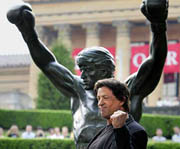
Rocky and Sylvester in Philly. Bronze by A. Thomas Schomberg
ADDENDUM: THE FUTURE OF BRONZE SCULPTURE
This week on National Public Radio, Morning Edition ran a story on the disappearance of a 130 year-old sculpture of United States President Grant. Apparently, some people in the east African nation Guinea-Bissau stole and cutup the bronze bust into scrape metal - a valuable commodity in the country. In our "Green" age, perhaps bronze has an advantage: It is 100% recyclable.

President Grant sold as scrape metal in Guinea-Bissau (NPR story)
NOTES
1. Since Winston-Salem, North Carolina, is my hometown, I am of course insulted that either Mount Airy - the actual Mayberry from the Andy Griffith Show - or Winston-Salem - the actual city of Mount Pilot in the show - are not the home of the TV LAND sculpture. I don't know how Raleigh stole the rights.
UPDATE: FROM JEFFERY YORK - Yes, unfortunately Raleigh was a recipient of the original statue, but shortly there after upon the instance of Andy Griffith and a vocal majority of Mt. Airy citizens, a second identical sculpture was produced for Mt. Airy. I attach an image of the sculpture outside the Andy Griffith playhouse in Mt. Airy, so you should no longer be disappointed. Mt. Airy now has "public art".
2. Studio EIS is featured in an interesting History Channel documentary on the making of three wax sculptures of George Washington. A team of professors in Pittsburg used every peice of George Washington's remains, paintings and artifacts to create 3D computer images of his face. Studio EIS converted the computer produced heads into the sculptures for Mount Vernon, Washington's home in Virginia. Good program.
Digg it...Del.icio.us ...Technorati...Stumble Upon..Reddit
In the comments for a previous blog, Margaret Koscielny wrote:
"Public Art" is an oxymoron; just like "Computer Art."
Weiss responds:
"Art can be privately discovered by the artist and be meaningful to others, therefore "Public Art"
Margaret Koscielny ellaborated: (Koscielny Website)
"I feel that "Public Art", as a term, is an oxymoron. Perhaps the solution is to allow public sentiment for memorials, or statements of common outrage, to be channeled towards specific commissions, instead of the open-ended kind, now common. Let the public subscribe with their own money, instead of taxpayer's money, to the erection of a "monument" to their sentiments. Then, whatever might be produced by the artist might be "art" instead of the pablum which "Public Art" has become.
Weiss responds:
A lot of government sponsored or supported public art is of lower quality, but so is a vast amount of privately supported art - public and private. Adding vitality to the public realm can come as sensitive decoration or angry sentiments.
Reis Niemi responds (Niemi Website)
Public Art is not an oxymoron.
Some of the work is indisputably Art, even if much of it is not.
And most of the work is displayed in public.
Thus, both words are true when discussing the work.
Calling it an oxymoron would mean that the two words contradict each other- which, of course, they dont. They might slide by each other in the night, unawares, but contradiction is something else.
I assume what is meant is the writer doesnt like public art.
But as we have discussed here before, there are at least three competing definitions of public art, and unless you specify which one you are talking about, its kinda meaningless.
There absolutely positively is a legal category of art, called Public Art, that is funded by 1% ordinances around the country, and produces actual physical objects that are not oxymorons.
Nobody says you have to like em. But they are real, and the name legally and in common english applies.
What is missing from the original article, and from Ms. Koscielny's mind, I would guess, is GOOD public art.
I can suggest a few pieces I think fall in that category, and I am sure Glenn can add a few more. By actually looking at the best stuff that is being done these days, it is possible to see what Mr. Petrovich has missed on Slate.com. (See Aesthetic Grounds Comment) Some of which may change his mind.
I personally recommend the following-
Buster Simpson- any of it- its all smart, snappy, and relevant-
Claudia Fitch- anything she does rocks, but this piece, inspired by roman statuary, is great-
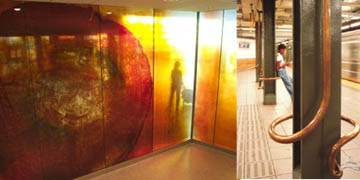
Linda Beaumont- Travelling Light, SeaTac Airport-
Its public, its art, and its goddamn gorgeous. Bobo IS the goddess.
James Garvey- Lariat Seat Loops, IRT station, 33rd St, NYC-
Elegant, subtle, functional,art, and its in public. He draws a line in space, right thru the subway station, and you can sit on it to boot.
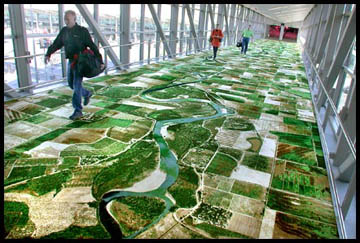
Sayed Alavi- Flying Carpet- Sacramento Airport
I dream of flying...
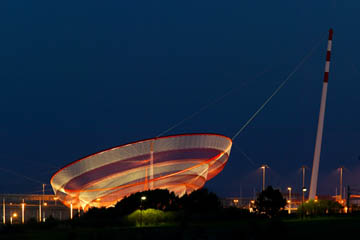
Janet Echelman- She Changes, Porto, Portugal
If this piece dont knock your socks off, you need a podiatrist.
I am also a big fan of many projects by Vito Acconci, Dan Peterman, the ART GUYS, Bob Irwin, Tom Otterness, and my lovely wife, Sheila Klein.
Virtually any public project by any of the above artists disproves the oxymoron theory.
Lots more good stuff out there as well, along with loads and loads of crap.
Margaret Koscielny reponds
As one who was commissioned to produce 4 walls, 9 x 13 feet for the Atlanta airport in 1979, I can assure you I know exactly what the "public" in Public Art means. As one who also produced numerous works for "public" spaces in Corporate headquarters and offices, I can also assure you that there is not much difference, when it comes to respecting the art.
My argument with most "public" art is that it is not respected, taken care of, nor, in many cases, chosen with any sensitivity to the environment in which it will exist. I do not necessarily mean the aesthetic environment, but the cultural and educational environment.
In my community, art created for public spaces has been most successful in the libraries, where the "commissioners" know their "public."
There are successful art works created for public spaces. Europe is full of them, and occasionally, some of the more sophisticated cities in this country. Even so,
where is the care that is needed once the work is up? Where is the educational effort to inform and explain the work to people who have no acquaintance with art?
This country has a poor history with generalized art education which would afford the "public" the
ability to respond to art which is "unfamiliar" and
challenging.
I am not against art in public places; I am against the visual "pablum" which is served in trying to please the "public."
Ries Niemi responds
Everything you say is true, and could equally well be said about Painting.
I was in a motel the other day, with 2 paintings- and they were visual pablum, which were obviously placed there to please the "public".
I am not against Painting- I am against BAD PAINTING.
The reality is that a few civic agencies do a great job of maintaining public art, and many others do not- much like bridges.
For public art to be successful, it is not enough to do the exact same work you would do in a gallery show- you must design the work from the beggining so it will survive, unloved and unattended, out in the real world.
Just as a painter must know his or her media and materials, a public artist must understand bi-metallic corrosion, what graffiti cleaning chemicals will do to their work, the lifespan of powder coating, how to manage a structural engineer to get invisible fasteners, and many more practical, real world things.
If it was easy, everybody would be doing it.
I am sorry, but no art, public or private, can change the art education of the general public.
I think the expectations and hurdles you place on public art are far more than you would put on the latest painting at MOMA.
There are many more compromises, and difficulties in making successful public art, and so, naturally, the great successes are few. But they are certainly there, right here in America.
PS- I have travelled extensively in Europe as well- and seen quite a few complete dogs of public art there- they dont have a magic bullet either.
It is completely unfair to everyone involved at Mass MOCA to describe the removal of Christoph Buchel's exhibition an act of censorship this fall. No single human being unilaterally ordered the destruction of a work of art before it was presented to the public, but that is exactly what happened. (Just quickly, due to extensive cost overruns and schedule delays, Mass MOCA asked the courts of Massachusetts to permit the organization to remove and effectively destroy the artwork without the artist's permission. Buchel objected, but refused to finish the work. See the excellent statement by Tyler Green and his links. Buchel photos are Basel 2005 and Mass MOCA 2007)
Normally the actions of the Mayor of Edmonton, Canada, would be seen as an act of censorship by one human against the particular work of an artist. The artwork was removed from public view because of the Mayor felt that the content of the artwork was offensive to some citizens and should not be supported by the government of Edmonton. (Just quickly, Hindu Society of Alberta petitioned the mayor to remove the sculptures depicting the Hindu god, Ganesha. Hindu residents felt the artworks by Ryan McCourt were "disrespectful treatments" especially due to the god's nudity and decapitation in one sculpture. The artworks were removed on September 22, 2007 from the Convention Center.)
Destroyer of Obstacles, by Ryan McCourt, 2006
(The title is a typical Hindu phrase for Ganesha)
Sculptures and Paintings of Ganesha
Ryan McCourt's work continues the cycle of artists unintentionally insulting newly empowered group of peoples. The Canadian Hindu's are inventing artistic boundaries for the use of Hindu gods as I write. Despite McCourt's claims of innocence and support by many Hindus, he appears to me to be manipulating symbols that he does not know from a lifetime of experience. The symbols are abstractions of ideas as diagrammed in the Ganesha illustration and combined with a cartoon character energy - which I enjoy, but from a position ignorant of Hindu meaning.
McCourt, the Mayor and the Hindu Society reminded me of the debates surrounding non-Native American artists making artworks with Native American iconography in NW North America. Just outside Seattle in the 1950s & 60s, Dudley Carter was a white, talented sculptor creating large wooden works with the traditional images from Native Americans in British Columbia and Alaska. By the 1970s, the Native Americans began to gain a stronger voice and complained in ways similar to the Hindus today. At first the mainstream culture had difficulty grasping the situation, but now as mature artists such as David Boxley of Washington State and Susan Point of British Columbia have achieved prominence, the difference between artists from the culture and artists inspired by a culture is very clear. The sense of respect for the traditions is very high as they make new unique works.
Unlike the last 30 years of public art by Native American artists, McCourt and the Hindu Society live in a visually connected globe. The public dialogue lives on electronically and helps find these boundaries of respectful interpretation that a government can support. Showing respect for all people may be the first rule of good democracy. McCourt is not censorship, but a step in a long process in which his personal views are now part of the history, not hidden from it.
Dudley Carter carving near Seattle from the 1950s and 60s
Susan Point, Coast Salish, Vancouver, Canada
David Boxley, Alaskan Tsimshian, Washington State, USA
Digg it...Del.icio.us ...Technorati...Stumble Upon..Reddit
Slate dumbs down the public art dialogue. Some new mover and shaker with connections named Dushko Petrovich has done public art a disservice manipulating history. But I do understand why Artsjournal Book/Daddy thinks this Slate.com article on public art is interesting. The language and methods of connections to other contemporary thoughts is sparkling.
BLOG UPDATE: SEE "comments section" FOR EXCELLENT RESPONSES FROM DUSHKO PETROVICH AND BOOK/DADDY plus thoughts from Ries Niemi, Margaret Koscielny, Julia and Peter Schoppert of the Singapore Public Art Blog. Some comments moved to OCTOBER 4, 2007 blog entry.
Slate.com
Writing for a general audience is difficult on any topic when you choose to address 500 years of outdoor sculpture in a reverse logarithmic progression. Petrovich compares permanent government funded artwork and with temporary artwork funded by the artist or the arts institutions. His obvious observation should have been that temporary artworks have more controversial content that engages the audience in the values of the artist. EXCEPT he fails to tell the reader the difference between the temporary and permanent.
He uses Serra's Tilted Arc has an example of empty messages rather than the vast number of politically charged temporary artworks in New York City at the same time. Actually the "Serra Epoch" was a tiny blip in the history of public sculpture. Only between 1950 and 1980 did the museum curators and experts control public sculpture. All other public sculpture in history has been and is controlled by people with multiple objectives, not just the presentation of fine art.
He finishes the article with one of Michael Singer's most pretty new works instead of Singer's complex works that are integrated with the environment and don't really look like art at all. But worst than not presenting Singer correctly, he implies that environmental integration is the same as political values. It is not. Singer is a talented artist that is breaking institutional barriers against creative problem solving and raising environment intelligence through build examples.
His article should have noticed the unbelievable amount of freedom that artists have today in presenting their point of view. Before 1950, when was public sculpture ever conceived as a legitimate venue to present personal values to the public? A huge number of governments, institutions and a media now expect some dialogue. Amazing compared with the other 500 years.
And yes because of the popularity of public sculpture with many governments, a lot of fun artwork with limited political speech is being commissioned. ( But then who does not like the Tevri Fountain in Rome. ) The difficulty is not artist speaking, but the general cultural domination of design. So much pretty stuff in the developed world. Artists and others are always attracted to whatever in popular.
Digg it...Del.icio.us ...Technorati...Stumble Upon..Reddit
Blogroll
AJ Ads
AJ Blogs
AJBlogCentral | rssculture
Terry Teachout on the arts in New York City
Andrew Taylor on the business of arts & culture
rock culture approximately
Laura Collins-Hughes on arts, culture and coverage
Richard Kessler on arts education
Douglas McLennan's blog
Dalouge Smith advocates for the Arts
Art from the American Outback
For immediate release: the arts are marketable
No genre is the new genre
David Jays on theatre and dance
Paul Levy measures the Angles
Judith H. Dobrzynski on Culture
John Rockwell on the arts
Jan Herman - arts, media & culture with 'tude
dance
Apollinaire Scherr talks about dance
Tobi Tobias on dance et al...
jazz
Howard Mandel's freelance Urban Improvisation
Focus on New Orleans. Jazz and Other Sounds
Doug Ramsey on Jazz and other matters...
media
Jeff Weinstein's Cultural Mixology
Martha Bayles on Film...
classical music
Fresh ideas on building arts communities
Greg Sandow performs a book-in-progress
Exploring Orchestras w/ Henry Fogel
Harvey Sachs on music, and various digressions
Bruce Brubaker on all things Piano
Kyle Gann on music after the fact
Greg Sandow on the future of Classical Music
Norman Lebrecht on Shifting Sound Worlds
publishing
Jerome Weeks on Books
Scott McLemee on books, ideas & trash-culture ephemera
theatre
Wendy Rosenfield: covering drama, onstage and off
Chloe Veltman on how culture will save the world
visual
Public Art, Public Space
Regina Hackett takes her Art To Go
John Perreault's art diary
Lee Rosenbaum's Cultural Commentary
Tyler Green's modern & contemporary art blog
